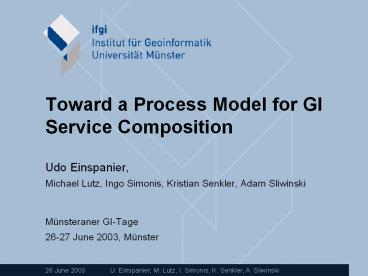Toward a Process Model for GI Service Composition - PowerPoint PPT Presentation
1 / 21
Title:
Toward a Process Model for GI Service Composition
Description:
Workflow-managed (translucent) chaining. Aggregate service (opaque chaining) 26 June 2003 ... translucent / opaque service chain. chain of actions. process ... – PowerPoint PPT presentation
Number of Views:13
Avg rating:3.0/5.0
Title: Toward a Process Model for GI Service Composition
1
Toward a Process Model for GI Service Composition
- Udo Einspanier,
- Michael Lutz, Ingo Simonis, Kristian Senkler,
Adam Sliwinski - Münsteraner GI-Tage
- 26-27 June 2003, Münster
2
Overview
- Motivation
- OGC and ISO RM-ODP
- State of the art in Web Service Composition
- XPDL
- BPEL4WS
- DAML-S
- Comparison Conclusion
3
Motivation
- Composability greatest value of (GI) web services
? Service Composition is a hot topic - Concepts for GI service composition have several
deficits, but... - ... there are a number of approaches outside the
GI domain - Goal Compare these approaches to OGC/ISO
approach and point out possible connections
4
ISO RM-ODP
- Specifies
- concepts and framework for the description of
distributed systems - characteristics that qualify a distributed system
as open - Objective development of standards that allow
distributed services in a heterogeneous
environment - Division of an ODP system into 5 viewpoints
5
ISO RM-ODP Viewpoints
6
OpenGIS and ISO 19100
- RM-ODP only provides the big picture
- Specification of geospatial processing components
is the objective of OGC ISO 19100 - concepts
- service
- interface
- operation
- service chain
- workflow
7
3 types of service chaining
- User defined (transparent) chaining
- Workflow-managed (translucent) chaining
- Aggregate service (opaque chaining)
8
Limitations
- No uniform model to integrate web services into
higher level architectures or business processes - No descriptive language to define a chain and
rules or execution constraints - Only weak approaches to ensure semantic
interoperability
9
XML Based Process Definition Language (XPDL)
- XPDL is a graph-structured process definition
language - XPDL describes a process definition in terms of
- what is to be done,
- when it has to be done,
- under what conditions, and
- by whom or what
- activity is the key concept of an XPDL process
definition
10
XPDL Language Details
11
What about Web Services?
- An external reference can be defined that points
to an application, e. g. a web service - Mature metamodel
- Lacks crucial concepts for building processes on
web service architectures
12
BPEL4WS a.k.a BPEL
- XML-based process definition language released by
IBM, Microsoft and BEA - supersedes process definition languages XLANG and
WSFL - models the behaviour of web services in a
business process interaction
13
BPEL Concepts
- BPEL builds on top of WSDL ? stateful extension
- BPEL supports two kinds of business processes
- Business protocols specify the mutually visible
message exchange behaviour without revealing
internal behaviour. - Executable business processes model actual
behaviour of participant in a business
interaction.
14
BPEL Language Details
- A BPEL process has three main parts
- partners (i.e. either a service the process
invokes or those that invoke the process), - activities (i.e. an operation in a business
process), - containers (provide means to store messages that
constitute the state of the business process).
15
BPEL Information Flow
- Control flow is handled via service links
- interaction with each partner occurs through web
service interfaces - the structure of the relationship at the
interface level is encapsulated in service links. - Data flow is handled by containers.
- Message flow is handled by three types of
activities receive, reply, invoke
16
DAML-based Web Service Ontology (DAML-S)
- Both an ontology of and language for describing
services - Goal Enable automatic invocation, execution
monitoring, discovery and composition of web
services - Service description consists of
- service profile ? what it requires/provides
- service model ? how it works
- service grounding ? how it can be accessed
17
DAML-S Language Details
- atomic processescan be directlyinvoked
(WSDLgrounding) - composite processescan be decomposedinto other
processes - simple processes are used as views on atomic or
composite processes for planning and reasoning
18
Comparison of Concepts of OGC and ISO RM-ODP
- necessary for integration into OGC/ISO
architecture - lexical comparison
- based on core concepts
- XPDL workflow process activity, transition
information, workflow process definition - BPEL process, activity
- DAML-S simple, composite and atomic process
19
Comparison a first approximation
RM-ODP OGC
XPDL workflow process activity activity operation
XPDL transition information action transformation
XPDL workflow process definition ? workflow
BPEL process chain of actions translucent / opaque service chain
BPEL activity action
DAML-S simple process activity opaque service chain
DAML-S composite process chain of actions service chain
DAML-S atomic process activity operation
20
Conclusions Future Research
- OGC work currently lacks crucial concepts that
facilitate service composition - There are approaches outside the GI domain that
could compensate these limitations (e.g. XPDL,
BPEL, DAML-S) - A Comparison of concepts used in these approaches
to those used by OGC is vital, but difficult - Comparison has to be improved
- go beyond entity level ? properties and
relationships - take viewpoint-specific concepts intoaccount
21
Thank you! Questions?
- http//www.meanings.de
- X-Border
- DALI































